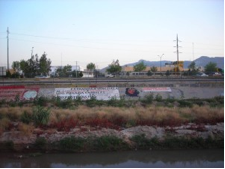The call came in early on a Saturday morning. Nora’s voice was filled with excitement. ‘My Gordo is on his way! He crossed on Thursday night, he got all the way to San Antonio really quick, just one try and he was on this side!’

Photo by David Danelo
It was still too early for me to make sense of anything Nora was saying. But from the tone of her voice I inferred that the day she had longed for had finally arrived. Ramón, her youngest brother, had finally managed to cross the border with the assistance of a coyote―the name given to human smuggling facilitators along the US-Mexico Border―in what appeared to be record time. When I asked for the name of the coyote, Nora replied a bit annoyed by what she probably interpreted as my inability to understand the magnitude of the event: ‘It was a woman. La Lady, they call her.’ Upon two payments of US$2,500 La Lady, a woman who worked facilitating crossings along the South-Eastern section of the US-Mexico border, had accomplished what no other smuggler had managed to do for Ramón on his past three failed attempts to cross the border. Less than 48 hours from the moment he arrived at the crossing point, La Lady had gotten him through.
Nora’s excitement was justified. Amid increasing border enforcement, treacherous environments, tensions connected to drug trafficking-related violence in Mexico, and the widespread criminalization of migration in the US, extralegal border crossings along the US-Mexico divide have become an often insurmountable feat. US immigration enforcement, together with socio-economic and political conditions in Mexico, have led not only to changes in irregular migration from this country, but also to changes in the makeup of extra-legal border crossing facilitation and its facilitators (see, for example, recent work by Simón Pedro Izcara Palacios and Peter Andreas). Yet the provision of human smuggling continues, adapting not only to new conditions on the ground but also by means of maintaining its role as a mechanism of protection from below for those unable to secure visa or passport protections. And, as Nora’s example shows, aside from being often financed by female relatives, many of these crossings are also facilitated by women.
Although often discursively portrayed by media and law enforcement as inherently violent and under the control of powerful and sanguinary transnational criminal organizations, smuggling is most often a trust- and referral-based activity, typically conducted among friends and family who collaborate with each other sporadically.
Despite the ubiquity of smuggling representations, the facilitation of extra-legal journeys continues to be an understudied area in migration. This is particularly evident in the case of women, whose experiences as smuggling facilitators have hardly been the subject of empirical research―let alone theorisation. Aside from being characterized as highly opportunistic individuals who exploit simple, pusillanimous border crossers, or who condemn young, naive, and virginal victims to the inferno of the sex trade, our understanding of female roles in smuggling continue to be conjectural and speculative. Research among female facilitators indicates that participation in smuggling often constitutes a supplemental income generating activity, as it’s carried out in addition to permanent and/or more stable jobs in the mainstream economy. Smuggling’s flexible schedule and highly specific division of labor often translates into women being able to participate without compromising childcare demands or the employment obligations that constitute their main source of income.

Photo by Daniel Danelo
While the roles performed in smuggling are highly gendered―the activities most commonly identified in smuggling like guiding desert treks, driving, or providing security or protection being most often performed by men―women’s roles in smuggling are also central to the success of border crossings. Not as visible in the state rhetoric of enforcement or media coverage as male smugglers, women in smuggling recruit customers, coordinate logistics, provide room and board, and often carry out basic financial transactions. Compensation is also highly feminized, for roles typically performed by men are paid at a higher rate than the tasks performed by women―oftentimes, women working alongside their spouses or romantic partners are even less likely than women working on their own to receive any kind of financial compensation.
The increase in scholarship on female migration and on approaches to women-led strategies for migration may lead us to believe there’s been a renegotiation of familial and gender roles within migrant households that may rationalize participation in smuggling as unproblematic or even justified. Yet, rather than a renegotiation of gender roles, I argue that facing diminishing opportunities for migrant and refugee immigration legalization, participation in human smuggling among women in the US has become an activity often devoid of the social stigma attached to other markets like sex work or drug sales. Perceived among those who rely on it as a mechanism for mobility―and if not entirely as a benevolent action carried out on behalf of the larger community―participation in smuggling constitutes for many women a legitimate employment alternative the light of vanishing hopes for immigration reform.
Gender is an important angle from which to analyze smuggling given the perceptions connected to the market. The characterization of smuggling as a crime carried out, on the one hand, by predatory men of color and with violence as an issue impacting women only, on the other, obscures not only the complex dynamics of smuggling. It hides the role of the nation-state in creating laws and policies which limit access to regularized mechanisms that enable human mobility and safe transits, and the wide spectrum of interactions taking place among the market’s participants.
Author affiliation: Gabriella Sanchez, Assistant Professor at the Center for the Advancement of Children, Youth, and Families at the Catholic University of America
This post is part of the joint blog series on ‘Gender and Migration’ co-hosted by Border Criminologies and COMPAS. Posts in this series will be published on both blogs every Friday until mid-July.
